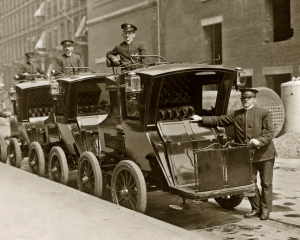New York City had a horse problem in the last 19th-century.
19世紀末的紐約市面臨了馬匹問題。
Its streets and alleyways were jammed with an estimated 150,000 of the animals -- each one producing more than 35 pounds of waste every day.
大街小巷被大約15萬匹馬堵得水泄不通,每匹馬每天產(chǎn)生超過35磅的排泄物。
The logistics of disposing that much excrement created an enormous challenge that New Yorkers were eager to solve. And a new invention -- the automobile -- seemed to be the answer.
運送處理這么大量的糞便成了紐約人急需解決的巨大挑戰(zhàn)。而這時,一項新發(fā)明--汽車--似乎成了答案。
When the city's very first motorized taxicab service launched in 1896, it featured a clean energy technology that might shown modern New Yorkers.
紐約市早在1897年就首次推出了機動計程車服務,當時所使用的清潔能源技術可能會讓現(xiàn)代紐約人感到震驚。
The cabs were electric vehicles. Produced by the straight forwardly named Electric Vehicle Company, the cars were known as Electrobats and were emerging as the market's leading electric vehicle.
這些計程車是電動車,名為“電池車”,開始成為市場上領先的電動車款式,制造商是名稱簡單明了的“電動車公司”。
Philadelphia inventors Henry Morris and Pedro Salom patented the Electrobat in 1894 and in two years had developed a smaller, faster version.
1894年,費城的發(fā)明家亨利·莫里斯和皮德羅·薩羅姆取得了電池車的專利,并在兩年內(nèi)開發(fā)出更小、更快速的車型。
Weighing in at 2,900 pounds, the new model was propelled by a lead-acid battery.
新車重達2900磅,以鉛酸電池驅(qū)動。
It achieved a top speed of 20 miles an hour and was capable of covering distances of up to 25 miles on a single charge.
其最高時速可達20英里,且一次充電可行駛25英里。
The idea of EVs gliding around New York City in the 1890s might sound like science fiction, but battery-powered automobiles outsold their internal-combustion counterparts at the dawn of the automative age.
電動車穿梭在19世紀90年代的紐約市,這聽起來或許像科幻小說情節(jié),但在汽車時代剛來臨之際,電池驅(qū)動的汽車銷量一度超越內(nèi)燃引擎車。
Electric cars were quiet, clean, and easy to drive.
電動車安靜、環(huán)保且易于駕駛。

"Back then, you were lucky if a gas car started in the morning," says Dan Albert, author of Are We There Yet? The American Automobile Past, Present, and Driverless. "It was noisy, polluting, and rickety, whereas an electric car started with a flip of the switch."
正如《我們到了嗎?美國汽車的過去、現(xiàn)在與自動駕駛》書的作者丹·艾柏特所說:“在那個時代,汽油車如果能在早上發(fā)動成功,就算是幸運的了。汽油車噪音大、不環(huán)保,且搖晃不穩(wěn),而電動車只要一轉(zhuǎn)開關就能發(fā)動。”
This was the dawn of the age of electricity, a moment in time when technologies harnessing the power source seemed capable of overcoming any challenge.
當時正是電力時代的黎明,使用電力的技術似乎能夠克服所有難題。
"If you asked people on the street what was going to happen, they would have said the electricity is this magic force," says electric car historian David A. Kirsch, author of The Electric Vehicle and the Burden of History.
電動車歷史學家大衛(wèi)·A·克茨著有《電動車與歷史重擔》一書,他說:“如果你問路人未來會怎么樣,他們一定會說電力是一種神奇的力量。”
"We harnessed it for light. We harnessed it for traction through the trolley. It's spreading everywhere, and now it's going to take us around."
“我們利用電力來照明、利用它來牽引電車。電力正在逐漸擴展應用范圍,現(xiàn)在也要成為載運我們的動力。”
Morris and Salom brought the Electrobat to New York and devised an ingenious battery-swapping system inside a former Broadway ice-skating rink to keep the company's cabs in continuous operation.
莫里斯和薩羅姆將電池車帶到紐約,并在以前的百老匯溜冰場內(nèi)設計了一套巧妙的電池更換系統(tǒng),以確保公司的計程車能持續(xù)運行。
Employees maneuvered vehicles with elevators and hydraulics so that an overhead crane could pluck out the depleted 1,250-pound batteries and insert freshly charged ones. The process took only three minutes.
員工利用升降機和液壓設備來移動車輛,利用頭頂?shù)醣廴〕?250磅重的空電池,并插入充滿電的新電池。整個過程僅需三分鐘。
"It was much faster than changing a horse team and probably as fast as what we would today associate with filling a tank of gas," Kirsch says.
“這遠比更換馬車隊的馬匹還快,可能和我們現(xiàn)在加滿一箱油的速度差不多。”克茨說。












